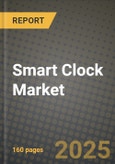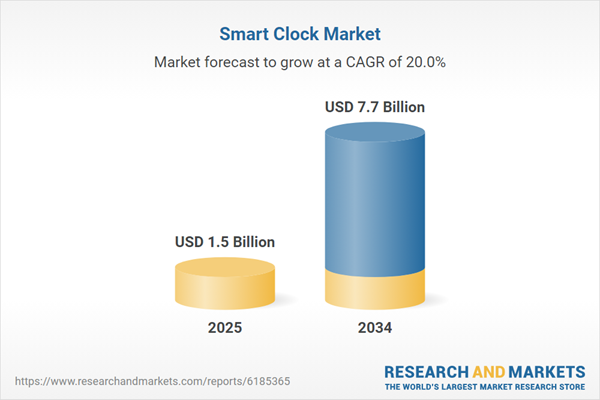The smart clock market is steadily gaining traction as consumers seek more connected, multifunctional devices for their homes and offices. Unlike traditional timepieces, smart clocks integrate features such as voice assistants, smart home control, Bluetooth speakers, customizable alarms, and touchscreen displays. These clocks serve not only as timekeepers but also as lifestyle hubs - providing weather updates, traffic alerts, reminders, and even fitness or sleep tracking. Many smart clocks are also compatible with IoT ecosystems like Amazon Alexa, Google Assistant, and Apple HomeKit, enabling users to manage other smart devices directly from their bedside or desktop. With the growing popularity of home automation, especially in urban settings, the smart clock is evolving from a novelty item into a central part of modern digital living. As consumers become more accustomed to voice commands and centralized control systems, the demand for compact, intelligent, and aesthetically pleasing smart clocks is expected to increase across both residential and commercial segments.
The smart clock market experienced significant product innovation and broader adoption driven by the integration of AI and enhanced user personalization. Manufacturers launched new models featuring ambient light sensors, advanced sleep monitoring, gesture control, and dynamic user interfaces. Smart clocks with built-in cameras and microphones began gaining popularity for video calling and home surveillance, especially in multifunctional living spaces. Compact smart clocks targeting minimalist consumers also emerged, focusing on subtle design and essential features like weather forecasts, calendar syncing, and silent alarms. Voice assistant integration became nearly universal, with Amazon Echo Show and Google Nest Hub Mini-type products dominating the mid- and entry-level market segments. The growing demand for smart home hubs contributed to the increasing bundling of smart clocks with lighting and HVAC control systems. Meanwhile, educational institutions and workplaces explored smart clocks as productivity tools, using features like digital reminders, scheduling, and voice memo functionalities to streamline day-to-day operations. Retailers reported strong seasonal sales of smart clocks during back-to-school and holiday periods, suggesting growing consumer awareness and acceptance.
The smart clock market is poised to evolve in line with advancements in AI, energy efficiency, and cross-device interoperability. Future smart clocks will likely integrate machine learning algorithms to analyze user habits and automate personalized routines - adjusting alarms, lighting, or environmental settings based on behavioral patterns. Enhanced privacy controls, such as physical camera shutters and data encryption protocols, will be incorporated to address consumer concerns around surveillance and data collection. Expect smart clocks to expand their role as wellness companions, offering breathing exercises, mood lighting, and even voice-guided meditation. With smart city infrastructure maturing, smart clocks could also provide real-time public transportation updates, emergency alerts, and hyper-local news. Moreover, interoperability across platforms will improve, enabling seamless syncing with smartphones, tablets, wearables, and home appliances. However, for broader adoption, manufacturers will need to strike a balance between feature-rich designs and affordability while ensuring compliance with emerging standards in digital security and sustainability.
Key Insights: Smart Clock Market
- Rise of Multi-Functional Smart Displays: Consumers are gravitating toward smart clocks that double as digital assistants, media players, and home control hubs - delivering information, entertainment, and smart device management from a compact form factor.
- Integration with Health and Wellness Features: Smart clocks are incorporating wellness-oriented features such as sleep tracking, silent alarms, guided breathing, and circadian lighting, transforming bedside clocks into health-enhancing tools.
- Voice Assistant Standardization: Integration of Alexa, Google Assistant, and Siri has become standard, making voice control a core feature in smart clock usage for scheduling, reminders, and controlling other smart home devices.
- Adoption in Educational and Work Settings: Institutions and offices are adopting smart clocks to assist with scheduling, reminders, productivity cues, and digital collaboration through built-in voice memos and display prompts.
- Emphasis on Aesthetic and Compact Designs: Manufacturers are focusing on minimalist, sleek designs that blend into modern décor while offering intuitive interfaces and essential smart features in smaller footprints.
- Growing Smart Home Ecosystem Adoption: As more households adopt smart lighting, security, and climate systems, smart clocks serve as convenient control hubs for centralized, room-based automation.
- Demand for Lifestyle and Wellness Tech: Consumers are seeking devices that not only perform functional tasks but also support personal wellness goals, prompting interest in clocks with sleep support and mood management features.
- Rising Use of Voice-Activated Technology: The widespread use of voice commands for everyday tasks is fueling demand for smart clocks that offer hands-free interaction and voice assistant integration.
- Increased Focus on Hybrid Living and Working: With remote work and home-based education becoming more common, smart clocks provide time management tools that enhance productivity and daily routine structuring.
- Privacy and Data Security Concerns: As smart clocks integrate microphones, cameras, and cloud connectivity, users are increasingly concerned about surveillance risks, requiring brands to implement robust privacy settings and transparent data handling practices to build consumer trust.
Smart Clock Market Segmentation
By Type
- iOS System Clocks
- Android System Clocks
- Other Types
By Distribution Channel
- Specialty Stores
- Online
- Other Distribution Channels
By Application
- Children
- Adults
- Other Applications
Key Companies Analysed
- Samsung Electronics Co. Ltd.
- Huawei Technologies Co. Ltd.
- Sony Corporation
- Withings SAS
- Lenovo Group Limited
- LG Electronics Inc.
- Xiaomi Corporation
- Anker Innovations Limited
- Koninklijke Philips N.V.
- AsusTek Computer Inc.
- Harman International
- Roku Inc.
- Bose Corporation
- Timex Group USA Inc.
- Casper Sleep Inc.
- InFocus Corporation
- Panasonic Holdings Corporation
- iHome Inc.
- Hatch Retail Inc.
- Ultimate Ears Inc.
- Clockwork Synergy Inc
Smart Clock Market Analytics
The report employs rigorous tools, including Porter’s Five Forces, value chain mapping, and scenario-based modeling, to assess supply-demand dynamics. Cross-sector influences from parent, derived, and substitute markets are evaluated to identify risks and opportunities. Trade and pricing analytics provide an up-to-date view of international flows, including leading exporters, importers, and regional price trends.Macroeconomic indicators, policy frameworks such as carbon pricing and energy security strategies, and evolving consumer behavior are considered in forecasting scenarios. Recent deal flows, partnerships, and technology innovations are incorporated to assess their impact on future market performance.
Smart Clock Market Competitive Intelligence
The competitive landscape is mapped through proprietary frameworks, profiling leading companies with details on business models, product portfolios, financial performance, and strategic initiatives. Key developments such as mergers & acquisitions, technology collaborations, investment inflows, and regional expansions are analyzed for their competitive impact. The report also identifies emerging players and innovative startups contributing to market disruption.Regional insights highlight the most promising investment destinations, regulatory landscapes, and evolving partnerships across energy and industrial corridors.
Countries Covered
- North America - Smart Clock market data and outlook to 2034
- United States
- Canada
- Mexico
- Europe - Smart Clock market data and outlook to 2034
- Germany
- United Kingdom
- France
- Italy
- Spain
- BeNeLux
- Russia
- Sweden
- Asia-Pacific - Smart Clock market data and outlook to 2034
- China
- Japan
- India
- South Korea
- Australia
- Indonesia
- Malaysia
- Vietnam
- Middle East and Africa - Smart Clock market data and outlook to 2034
- Saudi Arabia
- South Africa
- Iran
- UAE
- Egypt
- South and Central America - Smart Clock market data and outlook to 2034
- Brazil
- Argentina
- Chile
- Peru
Research Methodology
This study combines primary inputs from industry experts across the Smart Clock value chain with secondary data from associations, government publications, trade databases, and company disclosures. Proprietary modeling techniques, including data triangulation, statistical correlation, and scenario planning, are applied to deliver reliable market sizing and forecasting.Key Questions Addressed
- What is the current and forecast market size of the Smart Clock industry at global, regional, and country levels?
- Which types, applications, and technologies present the highest growth potential?
- How are supply chains adapting to geopolitical and economic shocks?
- What role do policy frameworks, trade flows, and sustainability targets play in shaping demand?
- Who are the leading players, and how are their strategies evolving in the face of global uncertainty?
- Which regional “hotspots” and customer segments will outpace the market, and what go-to-market and partnership models best support entry and expansion?
- Where are the most investable opportunities - across technology roadmaps, sustainability-linked innovation, and M&A - and what is the best segment to invest over the next 3-5 years?
Your Key Takeaways from the Smart Clock Market Report
- Global Smart Clock market size and growth projections (CAGR), 2024-2034
- Impact of Russia-Ukraine, Israel-Palestine, and Hamas conflicts on Smart Clock trade, costs, and supply chains
- Smart Clock market size, share, and outlook across 5 regions and 27 countries, 2023-2034
- Smart Clock market size, CAGR, and market share of key products, applications, and end-user verticals, 2023-2034
- Short- and long-term Smart Clock market trends, drivers, restraints, and opportunities
- Porter’s Five Forces analysis, technological developments, and Smart Clock supply chain analysis
- Smart Clock trade analysis, Smart Clock market price analysis, and Smart Clock supply/demand dynamics
- Profiles of 5 leading companies - overview, key strategies, financials, and products
- Latest Smart Clock market news and developments
Additional Support
With the purchase of this report, you will receive:- An updated PDF report and an MS Excel data workbook containing all market tables and figures for easy analysis.
- 7-day post-sale analyst support for clarifications and in-scope supplementary data, ensuring the deliverable aligns precisely with your requirements.
- Complimentary report update to incorporate the latest available data and the impact of recent market developments.
This product will be delivered within 1-3 business days.
Table of Contents
Companies Mentioned
- Samsung Electronics Co. Ltd.
- Huawei Technologies Co. Ltd.
- Sony Corporation
- Withings SAS
- Lenovo Group Limited
- LG Electronics Inc.
- Xiaomi Corporation
- Anker Innovations Limited
- Koninklijke Philips N.V.
- AsusTek Computer Inc.
- Harman International
- Roku Inc.
- Bose Corporation
- Timex Group USA Inc.
- Casper Sleep Inc.
- InFocus Corporation
- Panasonic Holdings Corporation
- iHome Inc.
- Hatch Retail Inc.
- Ultimate Ears Inc.
- Clockwork Synergy Inc.
Table Information
| Report Attribute | Details |
|---|---|
| No. of Pages | 160 |
| Published | October 2025 |
| Forecast Period | 2025 - 2034 |
| Estimated Market Value ( USD | $ 1.5 Billion |
| Forecasted Market Value ( USD | $ 7.7 Billion |
| Compound Annual Growth Rate | 19.9% |
| Regions Covered | Global |
| No. of Companies Mentioned | 21 |









